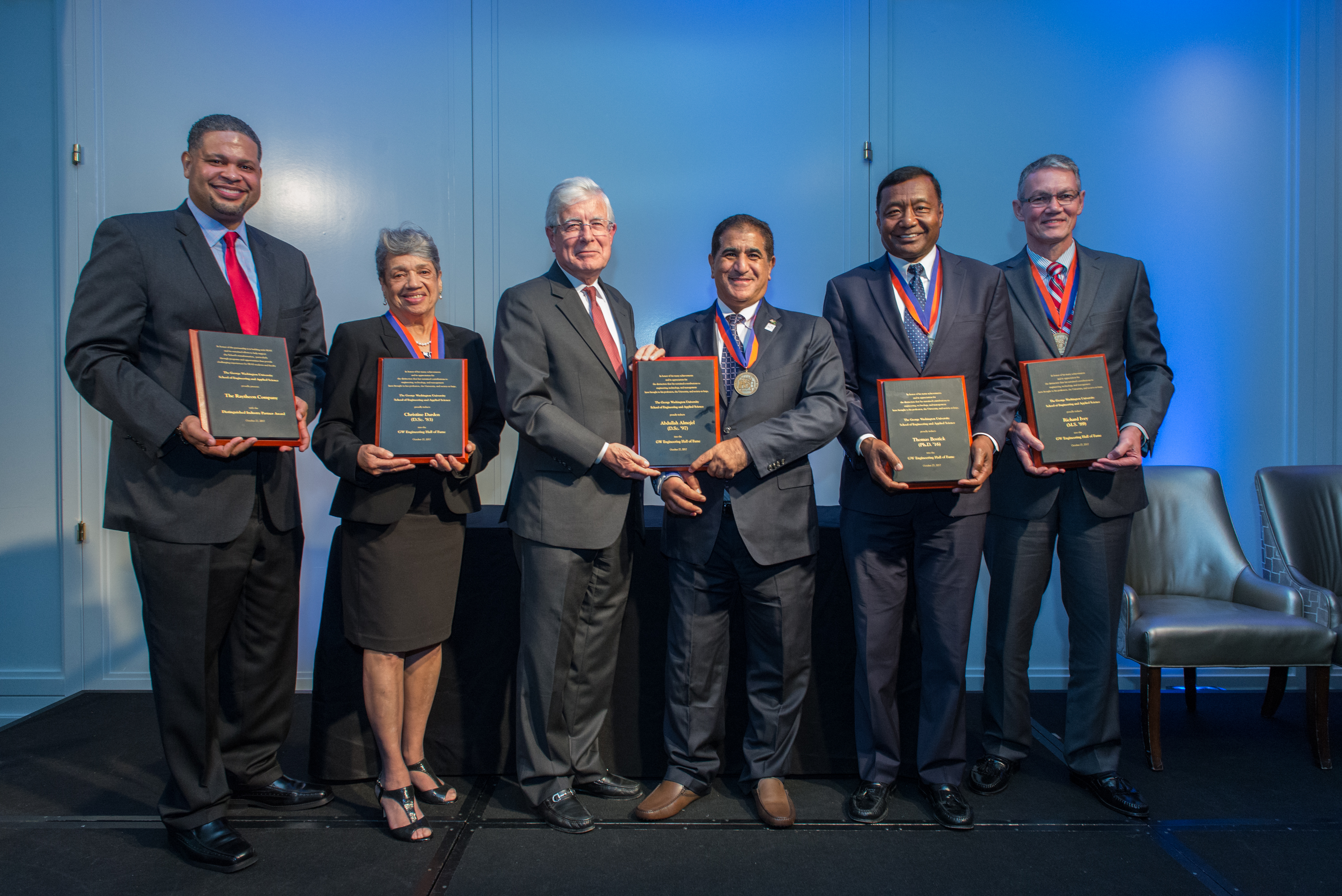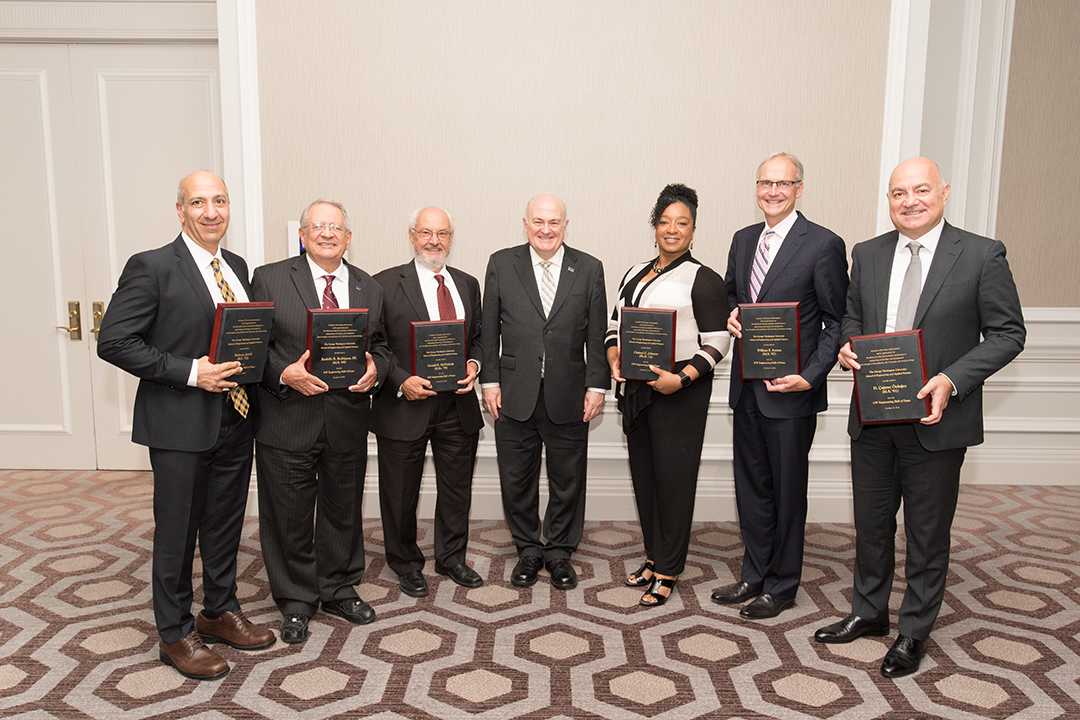By Kristen Mitchell
The School of Engineering and Applied Science inducted four alumni and one professor into its Hall of Fame Friday evening. The inductees joined the 66 members who have been inducted since 2006— all alumni, professors and friends of SEAS who have made significant contributions to the fields of engineering, technology, management or public service.
David Dolling, dean of SEAS, kicked off the Friday night event at the Fairmont Washington, D.C., by applauding the contributions of the inductees— Abdullah Almojel, Ph.D. ’97 and founding president of Global Dimension for Education and Training; retired Lt. Gen. Thomas Bostick, Ph.D. ’16, U.S. Army Chief of Engineers and Commanding General of the U.S. Army Corps of Engineers and senior vice president of the environment sector at the biotechnology company Intrexon; Christine Mann Darden, Ph.D. ’83 and internationally recognized NASA expert in the field of sonic-boom minimization; Rachelle Heller, a SEAS computer science professor and pioneer in recruiting women into STEM fields who joined the faculty in 1985; and Richard Ivey, M.S. ’89 and worldwide vice president for research for diagnostics systems at Becton Dickinson Company.
Dr. Dolling said the Hall of Fame inductees represent the “best of engineering and computer science at GW.”
“It’s a wonderful reminder of the strength and versatility of engineering,” Dr. Dolling said. “It’s a fun opportunity to brag a bit about our alumni and what they do and what they achieve.”
Dr. Darden began her career at NASA as a “human computer” in 1967 and was featured in the 2016 book “Hidden Figures: The American Dream and the Untold Story of the Black Women Mathematicians Who Helped Win the Space Race” as one of the pioneering African American women who helped the United States successfully launch astronauts into space.
“While supporting the engineers for five years, I realized that the equations they were bringing in to be solved were the same types that I worked in graduate school, and that’s what I really wanted to be doing,” she said.
After months of asking, she was reassigned to work on sonic boom minimization and enrolled at GW, where she eventually received her Ph.D. Her work on sonic boom minimization has been the building block for NASA’s plan to create a supersonic plane that will make air travel faster. The 2017 NASA budget included funding for this plane, and test flights are expected to take place in 2021.
Dr. Darden has all the qualities of a top flight researcher: focus, motivation and persistence, Dr. Dolling said, quoting Randy Graves, a SEAS alumnus, member of the GW Engineering Hall of Fame, and a former NASA director.
“She’s in NASA’s pantheon of super researchers, and the country needs more people like her,” he said.
Dr. Bostick, who spent 38 years in the Army, said a mentor encouraged him to pursue a Ph.D., even though he was convinced he would never have the time to finish it. Mentors have played a significant role in steering him in the right direction with opportunities and leadership throughout his career, he said.
“Too often we don’t thank those who educate us,” Dr. Bostick said. “We really rely on our educators, and 20 or 30 years later we produce someone like me who really benefitted from those educators.”
Being inducted into the Engineering Hall of Fame was an honor, Dr. Bostick said.
In working for Becton Dickinson, a global medical technology company that seeks to improve medical diagnostics and care, Mr. Ivey said he has never stopped learning. He encouraged future engineers to continue learning— and to pursue a master’s degree at GW.
“That has expanded my horizons, because I was really able to see what I could be, learn how to think,” he said.
George Washington President Thomas LeBlanc met with the inductees prior to the event to extend his congratulations.
This year Raytheon, an aerospace and defense company, was recognized with the 2017 Distinguished Industry Partner award. This honor is awarded to a company that has been committed to supporting SEAS growth.
More about this year’s inductees:
- Dr. Almojel has been an education and a senior leader in the Saudi higher education system for more than 20 years. In 2001, following his tenure as university professor, Dr. Almojel was appointed deputy minister for cultural relations in the Saudi Ministry of Higher Education.
- Dr. Bostick previously served as the 53rd U.S. Army Chief of Engineers and Commanding General of the U.S. Army Corps of Engineers, where he was responsible for most of the nation’s civil works infrastructure and military construction. This year he was elected to the National Academy of Engineering.
- Dr. Darden started her 40-year career at the NASA Langley Research Center in 1967 as a data analyst and started working at an aerospace engineer in 1973. She contributed a computer-based tool for the definition of the equivalent area of a minimum-boom aircraft for given flight conditions and became a member of the Senior Executive Service at NASA in 1999. She retired from NASA in 2007.
- Dr. Heller served as associate dean, and later as associate provost, of GW’s Mount Vernon Campus from 2003 to 2016. She has been a strong proponent of developing initiatives to introduce and retain girls and women in science, engineering, math and technology fields. She received the George Washington Award for her exceptional contributions to the university in 2010.
- Mr. Ivey has been with Becton Dickinson since 1982 and currently leads a team of more than 400 engineers and scientists located in six worldwide sites. Mr. Ivey has received multiple United States and worldwide patents in the field of bacterial sepsis detection. He was elected to the Maryland Science Center’s Board of Trustees in July.



